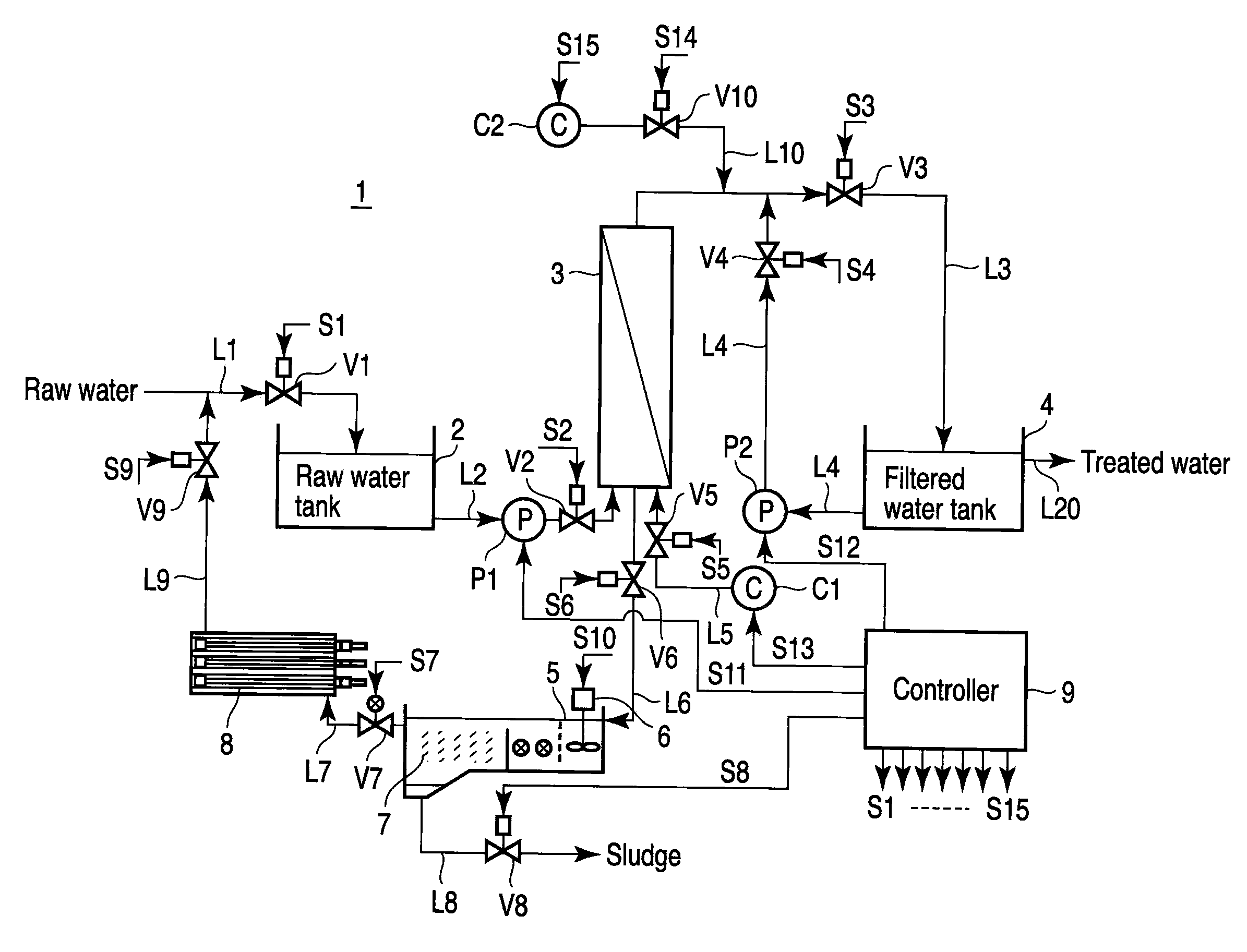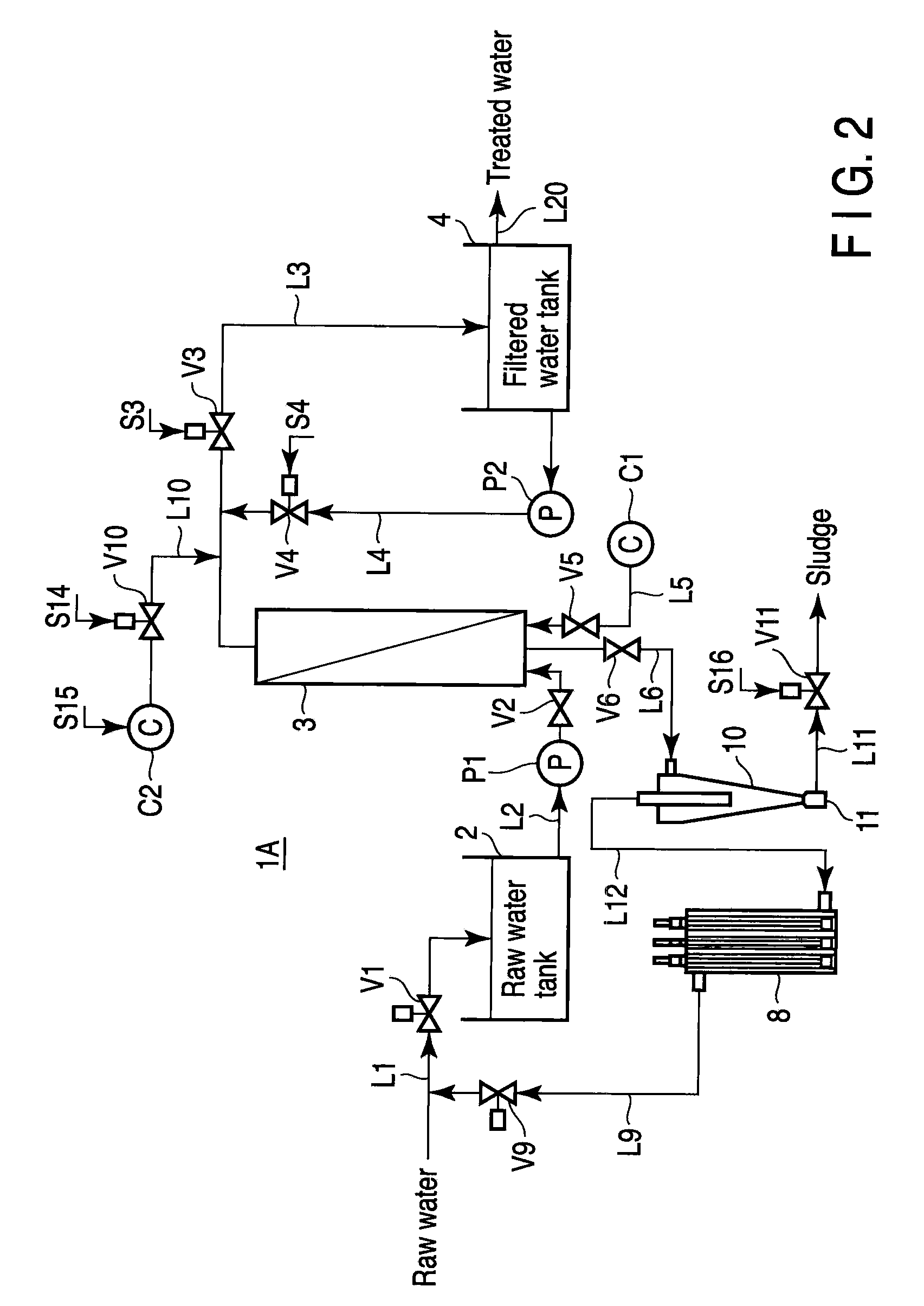Water treatment system
a technology of water treatment system and water permeation rate, which is applied in the direction of sedimentation settling tank, multi-stage water/sewage treatment, separation process, etc., can solve the problems of unsatisfactory discharge of wastewater containing infectious microorganisms, decrease of water permeation rate and water treatment capacity, and undesirable discharge of wastewater , to achieve the effect of reducing water purification cost, efficient disinfection of drainage, and improving the effective utilization ratio of raw water
- Summary
- Abstract
- Description
- Claims
- Application Information
AI Technical Summary
Benefits of technology
Problems solved by technology
Method used
Image
Examples
first embodiment
[0037]As shown in FIG. 1, a water treatment system 1 of the first embodiment includes a raw water tank 2, a membrane module 3, a filtered water tank 4, a flocculation tank 5, a the stirrer 6, a precipitator 7, an ultraviolet irradiation reactor 8, and a controller 9.
[0038]The raw water tank 2 is a reserve tank connected to a raw water supply source (not shown) via a line L1. The raw water to be treated (for example, river water) flows into the raw water tank 2 through the line L1. The raw water introducing line L1 has a flow rate control valve V1 controlled by the controller 9. A water outlet is provided at the bottom or near the bottom of the raw water tank 2. The water outlet communicates with the bottom of the membrane module 3 via a line L2. The line L2 has a feed pump (operation pump) P1 which feeds raw water from the raw water tank 2 to the membrane module 3. The line L2 has an on-off valve V2 which is controlled by the controller 9.
[0039]The membrane module 3 includes a filtr...
second embodiment
[0067]In the next place, the water treatment system according to a second embodiment of the present invention is described with reference to FIG. 2. Explanations of overlaps between the present embodiment and the above-described embodiment are omitted.
[0068]The system 1A in the present embodiment is different from the system 1 in the first embodiment in that a cyclonic solid-liquid separation device 10 is provided at the drainage treatment line L6 in place of the flocculation tank 5 and precipitator 7. The cyclonic solid-liquid separation device 10 is a centrifuge for physically and mechanically separating suspended solids in the sewage into solid and liquid components.
[0069]The inlet opened at the upper side of the cyclonic solid-liquid separation device 10 communicates with the drainage treatment line L6, into which the drainage from the membrane module 3 flows. The lowest portion of the cyclonic solid-liquid separation device 10 has a sludge collection vessel 11. The sludge colle...
third embodiment
[0075]The water treatment system according to a third embodiment of the present invention is described below with reference to FIG. 3. Explanations of overlaps between the present embodiment and the above-described embodiment are omitted.
[0076]The water treatment system 1B in the present embodiment is different from the system 1A in the second embodiment in that a cyclonic ultraviolet irradiation reactor 13 including ultraviolet lamps in a cyclonic solid-liquid separation device is provided at the drainage treatment line L6 in place of the cyclonic solid-liquid separation device 10 and ultraviolet irradiation drainage 8. The cyclonic ultraviolet irradiation reactor 13 is a centrifuge for physically centrifuging suspended solids in the sewage into solid and liquid components, and at the same time, irradiating microorganisms in the drainage with ultraviolet light for disinfection. The cyclonic ultraviolet irradiation reactor 13 is substantially the same as the apparatus disclosed in F...
PUM
| Property | Measurement | Unit |
|---|---|---|
| wavelength | aaaaa | aaaaa |
| diameter | aaaaa | aaaaa |
| length | aaaaa | aaaaa |
Abstract
Description
Claims
Application Information
 Login to View More
Login to View More - R&D
- Intellectual Property
- Life Sciences
- Materials
- Tech Scout
- Unparalleled Data Quality
- Higher Quality Content
- 60% Fewer Hallucinations
Browse by: Latest US Patents, China's latest patents, Technical Efficacy Thesaurus, Application Domain, Technology Topic, Popular Technical Reports.
© 2025 PatSnap. All rights reserved.Legal|Privacy policy|Modern Slavery Act Transparency Statement|Sitemap|About US| Contact US: help@patsnap.com



